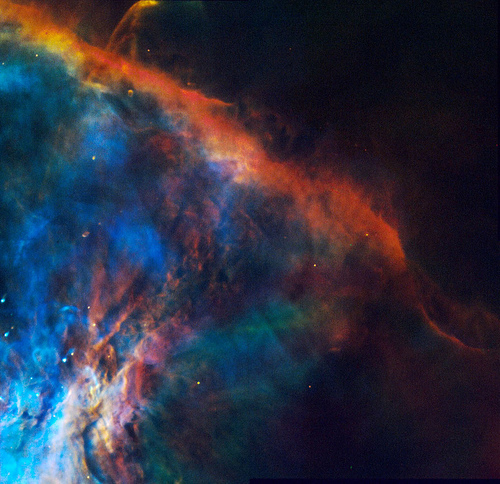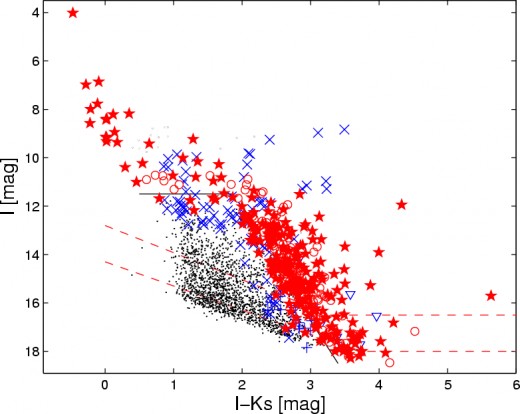What difference exists between stars and planets
NASA has found brown dwarfs that are good candidates for massive planets.





Most matter is the cosmos is dust, followed by sand grain sized objects, then pebbles and finally planets and stars.
The universe is organized from sub-atomic particles to galactic groups strung together in clusters and strings with large voids in between. In between these extremes of size are stars and planets that fill the vast expanses of space. The major difference between stars and planets is the fact that stars contain enough mass under the influence of gravity to ignite fusion and create energy, whereas planets do not. Usually the hierarchy is that stars occupy the center of stellar systems and planets orbit around the star. But this is not universal. Planets can exist well away from stars and most stars don't have planets because they exist in large groups in close proximity to one another. What astronomers have found is that about twenty percent of stars have planets in orbit around them. Stars can live in metal rich or metal poor regions of a galaxy. Those that evolve in metal poor regions seldom have planets. In the metal rich regions, there is a transitional hierarchy from dust, to planetoids, to planets, brown dwarfs, stars and super massive stars. As a general rule of the function of size, there are far more small objects in the cosmos than there are large ones like stars. Much of the visible mass that we can directly see exists in a state of plasma such as in stars, but there is far more mass that we cannot see.
Most of the mass in the universe thus is not found in stars, but in cold gas, dust, grain size particles, rubble, planetoids and planets. The term planet has come to generally mean a body in orbit about a star that does not give off its own luminosity. But there are a larger number of non luminous bodies not in any stellar orbit. They have no center except the galactic center, just like the stars. For lack of a better term, they can be called rogue objects or rogue planets. Planets in deep space have been found forming in the Orion nebula, near the edge of the galaxy known as MACHOs (Massive Compact Halo Objects) and in other regions. With what we have come to know, we can speculate that there are at least a few such bodies in deep space between us and the nearest stars. One of these is thought by some to be the "Nemesis" object that drives periodic extinction events on Earth. There is some proof that such an object as yet undiscovered; exists in deep space near our solar system. We have not found it yet as rogue planets are extraordinarily hard to find unless they are young and giving off infra red radiation.
The Earth and the neighboring planets orbit around a main sequence, moderately large yellow dwarf class star that has a surface temperature of about 5,600 degrees Celsius in the surface and 15 million degrees Celsius at the core. The sun is so massive that gravity is able to cause hydrogen to fuse and liberate energy. The energy keeps the sun from collapsing on itself and accounts for about a two percent mass loss to energy conversion in the hydrogen being fused. The interior of the sun has been doing this for over 4.55 billion years and more complex elements are being created as a result. By now, the sun has created helium and its isotopes, lithium, carbon and nitrogen. But the main elements created to date are hydrogen isotopes and helium and its isotopes. Most of the heavier elements were included in the primordial nebula that condensed to form the sun.
The orbiting planets in our solar system without exception do not fuse hydrogen into helium and thus do not give off light. Most planets with the exception of Jupiter receive more heat from the sun than they give off. Jupiter, due to its size, retains much of its primordial heat, so its heat output is greater than the sun's input. In our solar system, the planets are divided into two main groups; the inner rocky planets and the outer gas giants. There are other bodies as well consisting of ice and methane, but these generally tend to be smaller than the planets. These are the moons, the asteroids, comets and the trans-Neptunian Objects.
Examining the rocky planets we find that these have inner cores containing iron, nickel and heavier elements all the way to uranium. The regolith on the surfaces tends to have lesser mass elements like aluminum, silicon, oxygen, lithium, nitrogen, carbon and traces of helium and hydrogen. On Earth, much of the oxygen and hydrogen is locked up in the water. Earth is the inner planet that contains most of the hydrogen outside of the sun. Mercury, Venus and Mars have lost theirs. Hydrogen is not seen in abundance until water is able to freeze out at the freeze line in the asteroid belt near Jupiter’s orbit.
The outer planets contain a lot of hydrogen and traces of helium and heavier elements that allow atmospheres consisting of some methane to form. The presence of methane and other complex but light molecules make up the colorful clouds of Jupiter and Saturn. The main mass of Jupiter and Saturn is thought to be hydrogen with traces of helium, carbon, nitrogen and oxygen. These planets are thought to have rocky and possibly metallic cores under their deep atmospheres. A similar scenario is thought to exist for Uranus and Neptune, where the differences of color are accounted for by traces of water usually in the form of ice crystals. All of these planets reflect light from the sun, as they do not give off visible light on their own. Jupiter does glow in the infra red part of the spectrum, as do Earth and Venus, all for different reasons. No planet is massive enough in the solar system to fuse more massive elements out of hydrogen. For planets verging on being stars, we have to look outside of the solar system.
It is thought that a planet of some thirteen Jupiter masses is the lowest required mass in order to trigger either a lithium, deuterium based or helium 3 fusion process combined with hydrogen ions. Other theoretical considerations put the mass required between 75 to 80 Jupiter masses. A body just slightly less than this is often termed a failed star, still glowing, but mostly in the infra red due to contraction heating. These planets are able to sustain methane without degrading it. A planet this size exists in a borderline transition state between a planet and a star. If fusion can be successfully triggered and maintained, then a brown dwarf star is born. All bodies in the universe generally tend to increase in mass due to accretion, with the larger ones gobbling up the smaller. Thus a transitional planet can indeed become a star if it manages to accrete enough mass to push it over the gravitational threshold to ignite and maintain fusion. Indeed, an in falling mass of some size may even be the starting trigger for the fusion process. Bodies of this type are the most common type of star, simply due to the logarithmic function of size, i.e., the smaller bodies far outnumber the larger ones, which are by comparison, relatively rare. These stars ranging from thirteen to eighty Jupiter masses glow a dull ruddy red to dull red, which is why they are called brown dwarfs. They are hard to find due to their dimness and the diminutive size. As objects, they would not be much bigger than Jupiter, only far denser, with enough gravity to sustain small scale fusion. These stars are very long lived, considered to be capable of living at least 100 billion years before exhausting their fuel. Stars greater than eighty Jupiter masses are the red dwarf types and are easier to find due to giving off their own light.
We have been able to find objects that are borderline stars. There as at least fifty in the Orion Nebula alone. None are in orbit around stars, making them either brown dwarfs in the making, or super-massive rogue planets. They are all young and as a result, still have much of the contraction energy from accretion. They have been photographed by the Hubble telescope. Older ones that have cooled down, are thought to exist elsewhere, but are difficult to see. With improved space telescopes, one day we will find them. The fact that we now know of more than 400 extra solar planets, one of which we have imaged, tells us that we will find many more both in orbit around the stars or free in space. Some of the borderline planets will someday become stars when enough mass is accreted by them. This does go on. We see the evidence in the form of impact craters everywhere and the fact of known contact binary stars.
The Earth is highly unlikely to become a star. Instead, as the sun ages and expands, it is possible that the Earth will be swallowed up to become part of the bloated sun. At that time, both Mercury and Venus will have already met this fate.








